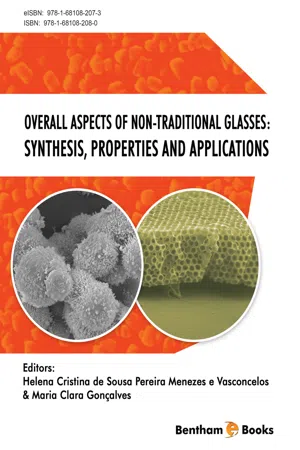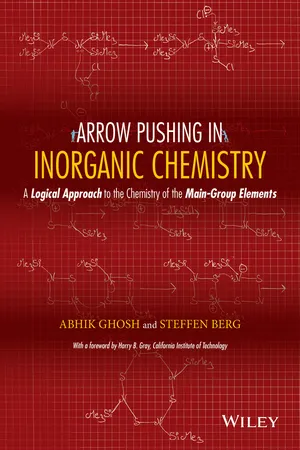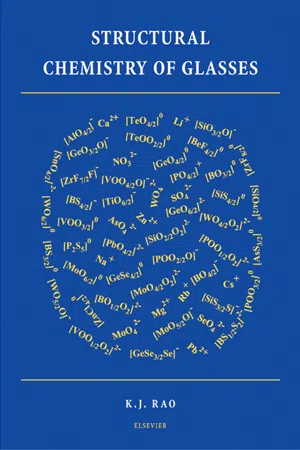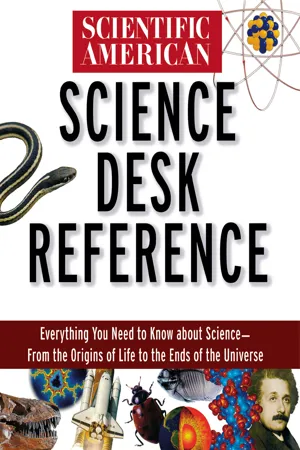Chemistry
Chalcogens
Chalcogens are a group of elements in the periodic table that includes oxygen, sulfur, selenium, tellurium, and polonium. They are characterized by their ability to form compounds with other elements, particularly metals, and are important in many chemical and biological processes. Chalcogens are also known for their diverse physical and chemical properties.
Written by Perlego with AI-assistance
Related key terms
Related key terms
1 of 4
Related key terms
1 of 3
5 Key excerpts on "Chalcogens"
- Helena Cristina de Sousa Pereira Menezes e Vasconcelos, Maria Clara Gonçalves(Authors)
- 2016(Publication Date)
- Bentham Science Publishers(Publisher)
Chalcogenide Glasses1.. Introduction
The term chalcogen was originally used to describe the elements of group 16 (or VIB) of the periodic table, O, S, Se, Te and Po, with ground state electronic configurations [He] 2s2 p4 , [Ne] 3s2 p4 , [Ar] 3d10 4s2 p4 , [Kr] 4d10 5s2 p4 and [Xe] 4f14 5d10 6s2 p4 , respectively (some of their properties are presented in Table 1). This term was first proposed in 1932 by Werner Fischer, a collaborator of Wilhelm Blitz from the Institute of Inorganic Chemistry at the University of Hannover, Germany, during studies on the relationship between the physical properties of chemical elements and their position in the periodic table [1 ]. In analogy to halogens (“salt formers”), it was proposed the name chalcogen (Ch) tosuch elements (“ore former”, from Compositions old Greek for “ore”), since they are all found as copper ores. Similarly to the halogenides, the chalcogen compounds were named chalcogenides. Presently the terms chalcogen and chalcogenide are frequently used only for sulfur, selenium and tellurium materials, and not for oxygen and oxides, polonium and polonium compounds. The much smaller electronegativity than oxygen (Table 1) justifies this distinction, as it leads to considerable different chemical and physical properties of the compounds, with the chalcogenides normally showing a decreased iconicity and increased covalency, when compared to oxides. Moreover, the presence of available low energy d orbitals also allows sulfur, selenium and tellurium to have valences higher than two, up to a maximum of six (as, for example, SF6 ).Table 1Selected properties of elements from group 16 [2 ].Element Atomic number Covalent radius (nm) m.p. (K) b.p. (K) - eBook - ePub
- Allen J. Bard, Roger Parsons, Joseph Jordan(Authors)
- 2017(Publication Date)
- CRC Press(Publisher)
6Sulfur, Selenium, Tellurium, and Polonium * STEPHAN I. ZHDANOV Institute of the Ministry of Chemical Industry, Moscow, USSROxygen, the first element in group VI, was considered in Chapter 4 . The electronic structure of the atoms of sulfur, selenium, tellurium, and polonium is close to that of the inert gases following them in the periodic chart. These elements, like oxygen, tend to add two electrons to form a complete shell consisting of eight s and p electrons. With growing atomic weight and the respective increase in the distance between the atomic nuclei and the outer electrons, however, the stability of the compounds with the oxidation state −2 decreases. In contrast to oxygen, the valency of sulfur, selenium, tellurium, and polonium may differ from −2, since they can form bonds by giving away s and p electrons from the d orbitals.On the whole, the group VI elements behave somewhat like nonmetals. The nonmetallic properties, however, become weaker as the atomic weight grows. Thus polonium and, to some extent, tellurium also display certain metallic properties. The group VI elements basically form covalent compounds. Thus one can speak about their oxidation states only formally.The most stable compounds of the lighter group VI elements (except oxygen) are those where the oxidation states are +4 and +6; the oxidizing power of the latter grows with atomic weight. In the oxidation state +2 the elements form unstable compounds that decompose into the free element and a compound with the oxidation state +4 (except polonium). The elements cannot form compounds with odd oxidation numbers and completed electron octets, save for the compounds where two atoms of an element of this group share two electrons (i.e., Na2 S2 ). Such compounds are, as a rule, less stable than those in which the oxidation state is even.I. Sulfur
A. Oxidation States
In sulfides the oxidation state of sulfur is −2. By forming covalent chains, sulfur atoms may yield poly sulfidesS X. The suboxide SO with the oxidation state +2 is a highly reactive biradical, but certain sulfoxylates, the salts of H2 SO2 corresponding to this oxide, were reported. The oxidation state of sulfur in thiosulfates2 −and in pentathiomatesS 2O 32 −also averages +2, while in hydrosulfateS 5O 62 −it is equal to +3 and in sulfiteS 2O 42 −SO 3, to +4. Sulfurous acid in the free states does not exist. In dithionates2 −the oxidation state of sulfur is +5 and in sulfatesS 2O 62 −SO 4it is equal to +6. Per-sulfate2 −is a peroxy compound. In some compounds, such as trithionatesS 2O 82 −and tetrathionatesS 3O 62 −, the average formal oxidation state of sulfur is a positive fractional number. It is convenient to divide all the oxygen-containing acids formed by sulfur into three groups of general formulas H2 SOx (x = 2 to 5), H2 S2 Ox (x = 2 to 8), and H2 Sx O6 (xS 4O 62 − - eBook - ePub
Arrow Pushing in Inorganic Chemistry
A Logical Approach to the Chemistry of the Main-Group Elements
- Abhik Ghosh, Steffen Berg(Authors)
- 2014(Publication Date)
- Wiley(Publisher)
Chapter 6Group 16 Elements: The Chalcogens
Linus Pauling: Have you ever smelled hydrogen selenide?Matthew Meselson: No, I never have.Pauling: Well, it smells much worse than hydrogen sulfide. …Now, hydrogen telluride smells as much worse than hydrogenselenide as hydrogen selenide does compared to hydrogensulfide … some chemists were not careful when workingwith tellurium compounds, and they acquired a conditionknown as “tellurium breath.” As a result, they have becomeisolated from society. Some even committed suicide.Meselson: Oh.Pauling: But Matt, I'm sure that you would be careful.Why don't you think it over and let me know if you wouldlike to work on the structure of some tellurium compounds?Interview between Pauling and then prospective graduate student Matthew Meselson, who during his subsequent tenure with Pauling did the Meselson–Stahl experiment, which proved the “semiconservative” nature of DNA replication.Two of the group 16 elements—oxygen and sulfur—are among the most familiar ones. Not only is water critical to all life and O2 to all aerobic life, the ozone layer protects life and civilization on Earth from the sun's harmful ultraviolet rays. The annual worldwide production of sulfuric acid is in the hundreds of millions of metric tons and is the highest by weight for all industrial chemicals. Indeed, the amount of sulfuric acid produced is often a good indicator of a country's state of industrial development and economic status. Interestingly, as a so-called Döbereiner triad (i.e., a triad of elements, whose chemical similarities were recognized by German chemist Johann Wolfgang Döbereiner in the nineteenth century), sulfur, selenium and tellurium played a role in the initial construction of the periodic table.Many group 16 compounds are malodorous, hydrogen sulfide (H2 S) being probably the most notorious example. Flatulence, bad breath, and skunk spray all contain hydrogen sulfide (H2 S), as well as other volatiles. Hydrogen sulfide is also toxic, so it's important to exercise caution so as to avoid exposure when working with H2 S in the laboratory. Interestingly, against this unattractive backdrop, H2 S has recently been recognized as a gasotransmitter, that is, a gaseous signaling substance in biology, comparable to NO and CO. Unfortunately, we will not be discussing this important biological role of H2 - eBook - ePub
- K.J. Rao(Author)
- 2002(Publication Date)
- Elsevier Science(Publisher)
CHAPTER 13CHALCOGENIDE GLASSES
SirAlexander Fleming, One sometimes finds what one is not looking for.In their importance, chalcogenides are next only to oxide glasses. Chalcogenide glasses are widely used for infrared transmission. Region of infrared transparency for some of the chalcogenide glasses are listed in Table 13.1 (column under λ) along with some other relevant properties.Table 13.1 Composition and properties of representative chalcogenide glassesn = refractive index;Tf= melting temperature; α = thermal expansivity; ρ = resistivity and λ = wavelength region of infrared transparency.(After Yamane and Asahara, 2000 ).Shown in Figure 13.01 are the percent transmission of a few important chalcogenides, which are transparent in the infrared region. The three elements S, Se and Te of Group VI with a valence shell ofns2 np4are known as Chalcogens. Although oxygen is at the top of this group, there are great many differences in the behaviors of oxygen and Chalcogens in their chemistry, particularly with reference to glass science. In their elemental states oxygen is only diatomic but, sulphur and selenium are constituted of octagonal rings (S8 and Se8 ). In the elemental Se glass, both rings and chains of various lengths have been identified. While S and Se are two coordinated, Te has been reported to be capable of 3-coordination (Cornet and Rossier, 1973 ) in tellurides. We have already referred to TeO2 containing glasses in which Te can be both three and four coordinated to O. S-S, Se-Se and Te-Te links occur extensively in glasses, but O-O peroxy linkage is unknown in glasses. Since the electronegativity drops steeply as we go from O to S in the periodic table, the nature of bonding of Chalcogens to other elements is far more covalent than the bonding of oxygens. Where as S and Se form glasses which are well-characterized, it has been found very difficult to quench O (and also Te) into glassy state. Since the valence state of O consists of only 2s and 2p orbitals, its bonding cannot involve any d - eBook - ePub
- (Author)
- 2008(Publication Date)
- Trade Paper Press(Publisher)
The C 60 molecules have been named buckminsterfullerenes because of their structural similarity to the geodesic domes designed by U.S. architect and engineer Buckminster Fuller. halogens The halogens are a group of five nonmetallic elements with similar chemical bonding properties: fluorine, chlorine, bromine, iodine, and astatine. They form a linked group in the periodic table of the elements, descending from fluorine, the most reactive, to astatine, the least reactive. They combine directly with most metals to form salts, such as common salt (NaCl). Each halogen has seven electrons in its valence shell, which accounts for the chemical similarities displayed by the group. chlorine Chlorine (Greek chloros “green”) is a greenish-yellow, gaseous, nonmetallic element with a pungent odor (symbol Cl). It is a member of the halogen group and is widely distributed, in combination with the alkali metals, as chlorates or chlorides. chlorine Fritz Haber developed chlorine gas for use by the Germans in World War I. Unable to live with this, his wife committed suicide in 1915. Chlorine is obtained commercially by the electrolysis of concentrated brine and is an important bleaching agent and germicide, used for sterilizing both drinking water and swimming pools. As an oxidizing agent it finds many applications in organic chemistry. The pure gas (Cl 2) is a poison and was used in gas warfare in World War I, where its release seared the membranes of the nose, throat, and lungs, producing pneumonia. Chlorine is a component of chlorofluorocarbons (CFCs) and is partially responsible for the depletion of the ozone layer; it is released from the CFC molecule by the action of ultraviolet radiation in the upper atmosphere, making it available to react with and destroy the ozone. The concentration of chlorine in the atmosphere in 1997 reached just over three parts per billion
Index pages curate the most relevant extracts from our library of academic textbooks. They’ve been created using an in-house natural language model (NLM), each adding context and meaning to key research topics.
Explore more topic indexes
Explore more topic indexes
1 of 6
Explore more topic indexes
1 of 4




